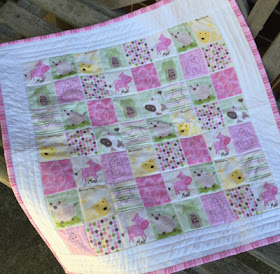Ah, Part 5, the favourite section of My Small World quilt, how do I love you?
Let me count the ways...
I love you for your Rainbow, half Dresden, New York Beauty arc and hexie hillock <3
And they are so simple when you know a few secrets!
Remember, I'm no expert. These are just a few techniques that have worked for me. I've learnt from other quilters over the years and just enjoy passing on their advice!
1. Half Dresden
This method gives a nice folded under edge to your Dresden blades, all ready for stress-free hand appliqué.
 |
First I made my own plastic template for the blades by tracing off the printed template (BC), but extending the sides upward and squaring off the top edge so it was no longer pointed, but wedge shaped.
I added a 1/4 inch seam allowance all round when I cut out my piece of fabric for my blade.
Then I folded my blade in half, and machined across the top with a 1/4 inch seam.
Using a reasonably pointy tool, I turned the blade right side out and pressed with the seam lined up down the centre. I used an oven thermometer for this because it wasn't so sharp that I might accidentally push a hole in my fabric, but a crochet hook would work well.
Once I had the required number of blades I machined them together, again with 1/4 inch seams, machining from the bottom up to the top of each one, machining beyond the end, then reversing and stitching a short way back so that I finished up about half an inch down from the top edge of my seam.
This meant I could snip off my threads well away from the edge of my Dresden arc, giving it a nice neat finish.
I appliquéd my semi-circle of "garden" to the half-Dresden arc using Floriani Stitch and Wash Fusible Water Soluble Tearaway Stabiliser.
Originally developed for machine embroidery, appliqué lovers have taken to it for appliqué because you simply iron your shape to the wrong side of your fabric, and lightly glue under the edges with a Sewline glue pen (or similar). Voila! It's ready to appliqué, and you never have to remove the Floriani because it just dissolves with washing. Not that you need hurry to do that because it doesn't feel unpleasant in your finished quilt.
Floriani make several similar-sounding stabilisers, so take care to remember the right one.
I used basically the same Dresden technique to make my little appliqué sun, but my tiny blade template was from the Westwood Acres Mini Dresden pattern and I used a lid to cut my circle.
2. The Hexie Hillock*
There are plenty of ways to obtain the papers for English Paper Piecing these tiny hexagons.
The easiest way is to design your own 1/2 inch hexagons using a site such as Incomptech, then download and print them onto light card.
To my mind the challenge of this little element of My Small World lies in trimming back the hand stitched hexes from this shape...
... to this ...
... without snipping those threads and potentially unravelling your hand stitching - Yikes!
Once again I turned to my roll of Floriani Stitch and Wash Fusible Water Soluble Tearaway Stabiliser, traced off the semi-circle shape from the printed template and fused (ironed) it to the back of my hexagon work.
Then I used a short stitch to machine around the Floriani, keeping close to the edge.
With the unravelling thus prevented, I could safely cut through the hand stitching as I trimmed the hexes back, leaving approximately 1/4 inch.
Then I folded this over, taking care to bring the line of machine stitching to the back where it was hidden and could not be seen on the edge, and my hexie hillock was now ready to appliqué!
*Well, it looks like a little hill to me :-)
3. The New York Beauty Arc
I thought I'd end this post with a block that looks complicated, but is very easily made using foundation paper piecing.
If creating from scratch is important to you, you can spend a very long time creating your own foundation papers from the pattern diagrams in Quiltmania.
Or you can English Paper Piece all those tiny, spiky slivers. On her latest blog post clever Danielle of Mes Petits Elephants has some fabulous instructions on how to do this.
Or you can do what I did, and pop over here to Sarah's blog where she has a simpler solution!
Phew, I think that's probably quite enough information for one post!
So next time, in my final post of Tips for My Small World Quilt, I'll cover construction of the rainbow, clam shells, orange peel blocks and pinwheels.
























































